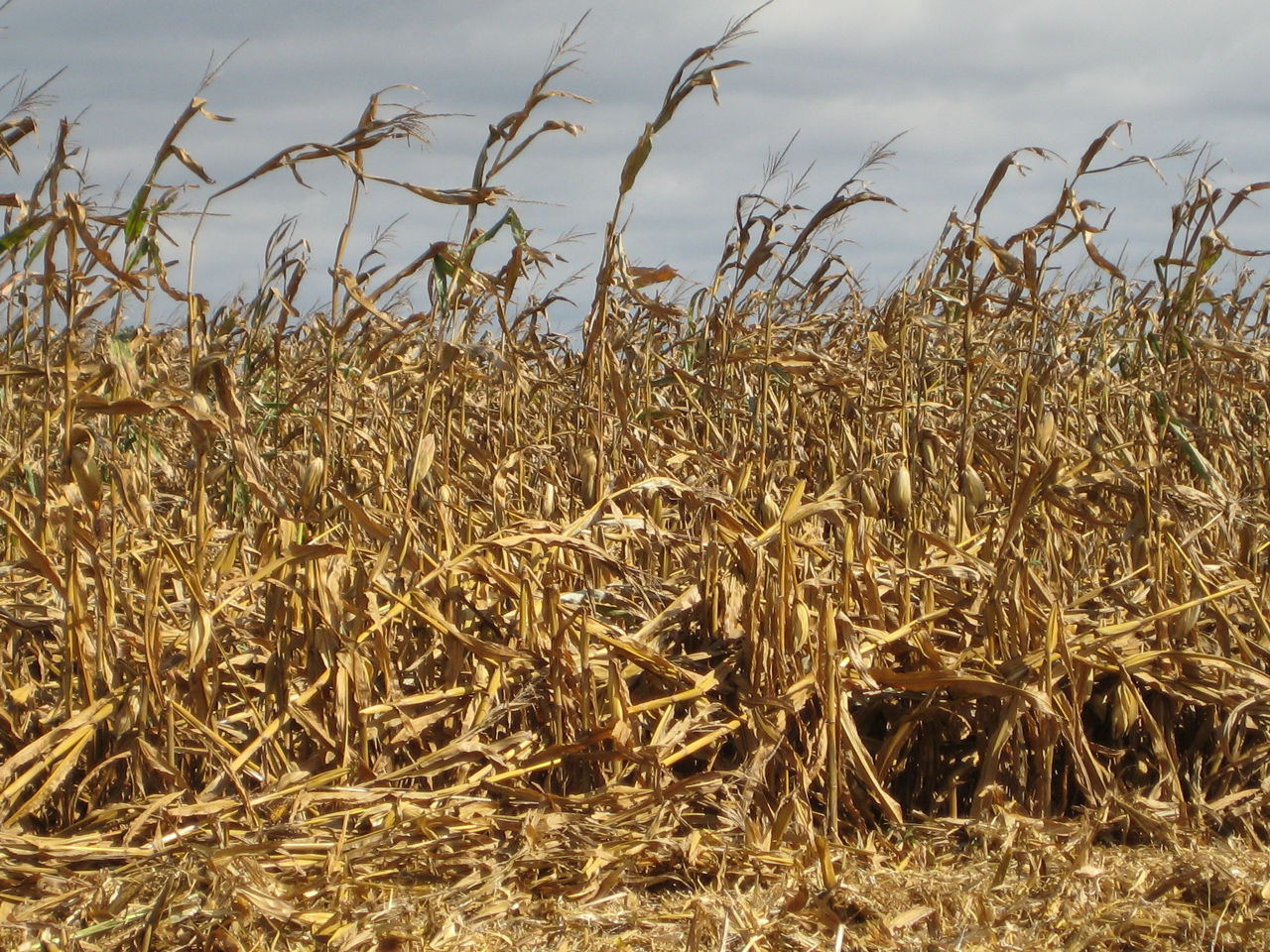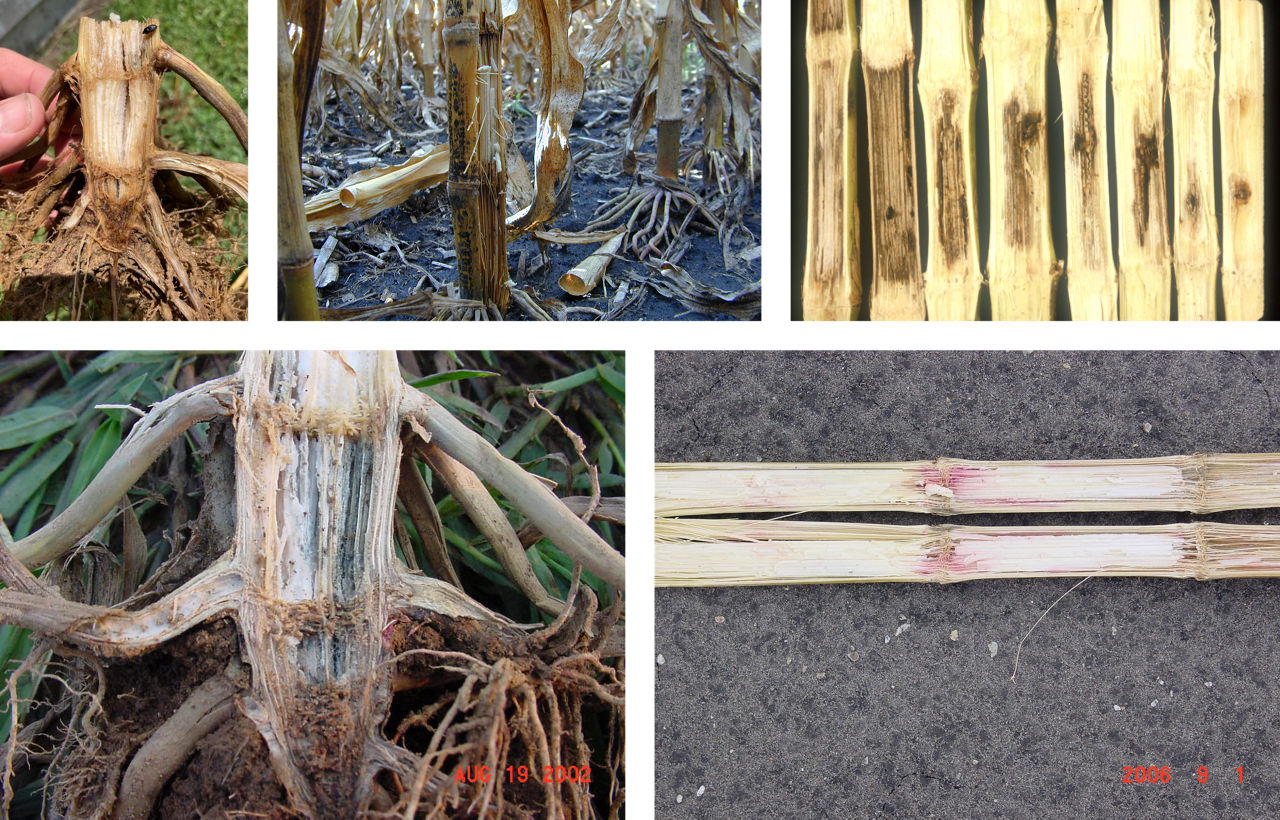Stalk Cannibalization in Corn
August 18, 2025
Stalk cannibalization is the remobilization of sugars from corn stalks to fill kernels that often occurs when the plant is under stress. This process results in reduced carbohydrate content in the stalks and can cause weakened corn plants at the end of the season. Cannibalization predisposes corn plants to stalk rots and lodging (Figure 1) and can lead to harvest difficulties that cause yield loss and volunteer corn problems in the following crop.

Factors That Can Lead to Stalk Cannibalization
Restricted root growth early in the season followed by dry conditions during grain fill can cause the plant to cannibalize nutrients and water from the stalk to nourish developing kernels. Root growth can be limited in fields planted late into saturated soils. Soil compaction, insect feeding, or injury from fertilizer or herbicides can also limit root growth. Reduced photosynthetic capacity from nutrient deficiencies, leaf diseases, or prolonged periods of cloudy weather can reduce photosynthetic capacity of the leaves and lead to stalk cannibalization. Excessive plant populations can increase plant-to-plant competition for light, water and nutrients, weakening the stalk structure. Weak stalks can lodge prematurely before black layer formation in the event of strong winds and heavy rainfall.1,2
Physiological Stalk Lodging
Physiological stalk lodging is usually the result of stress due to weather and one or more of the agronomic factors discussed above that limit the ability to supply adequate water and nutrients to meet demand. Stalk cannibalization can be the result of these interactions as grain fill takes priority over other plant functions. Stress occurring prior to pollination can slow the rate of plant growth due to reduced photosynthesis, resulting in less production of sugars in the leaves compared to non-stressed plants. During grain fill, when demand for nitrogen is high but the supply may be limited or exhausted in the soil profile, or if corn roots cannot take up adequate amounts of nutrients and water due to dry weather, the plant will begin to translocate carbohydrates from the stalks to complete kernel development. The weakened stalks become susceptible to lodging.1,2
Pathological stalk lodging is caused by the presence of one or more stalk rot diseases. One or more of the physiological stress factors mentioned above can weaken stalks and predispose them the invasion by pathogens that can cause stalk rots such as Diplodia stalk rot, Fusarium stalk rot, Anthracnose stalk rot or Gibberella stalk rot.
Diagnosis and Management
The level of cannibalization can be identified by splitting stalks and looking at the interior pith. Stalks weakened by cannibalization will have a pith that is white in color with a “styrofoam-like” consistency. The closer the cannibalized pith level is to the soil line, the more the stalk is weakened. When stalk rot infections have occurred, the diseased pith is often discolored. “Droopy” (declination) ears may also be observed where the shank becomes collapsed or crimped.3 Late season drought stress combined with cannibalization of the ear shank is similar to what happens when the main stalk is cannibalized. If corn ears have not yet reached physiological maturity, collapsed ear shanks can cause kernels to reach black layer prematurely, reducing grain yield. The presence of stalk cannibalization and stalk rots in corn may not always result in stalk lodging, especially if the affected crop is harvested promptly. Corn products also have different stalk strengths. However, a corn product with strong stalks and excellent standability is still prone to lodging due to cannibalization if harvest is delayed and the crop is subjected to strong winds and heavy rain.
Scouting should begin once the crop has surpassed growth stage R5.5 (1/2 milk line) and is approaching physiological maturity to monitor the general health of lower stalks. Fields should be scouted separately since the level of stalk cannibalization and rot can vary by product and from field to field. Particular attention should be given to stalk health in fields that have endured multiple stresses during the year and stressed by dry soil conditions during grain fill. Push or pinch tests can be used to check for weakened stalks that are prone to lodging. Begin by walking through the field in a zigzag pattern, select a plant and push the stalk to approximately a 45° angle noting whether the plant springs back, remains tilted, or breaks. Stalk firmness can be tested by squeezing or pinching each stalk at one of the lowest nodes above the brace roots. Healthy stalks are firm and cannot be compressed. If a stalk feels soft, it is prone to lodging. Check at least 10 plants in each of several locations in a field. If more than 10% of plants exhibit stalk cannibalization or rotting symptoms (Figure 2), it is recommended to harvest affected fields first to reduce the chance of plants lodging prior to harvest.4,5
Fields identified as high risk for stalk lodging should be scheduled for harvest as early as possible to reduce the risk of harvest losses. Take into consideration that upright corn, depending on stalk strength, is also at risk of lodging. Therefore, it can be challenging to decide how to prioritize when to harvest the downed corn and the upright corn. Knowing the percent of corn that is down or lodged along with the grain moisture can help determine harvest order.

Sources
1Thomison, P. 2019. Watch for corn stalk issues this fall. Ohio State University. Ohio Ag Net. https://ocj.com/?s=watch+for+corn+stalk+issues+this+fall.
2Nielsen, B. and Colville, D. Stalk lodging in corn: Guidelines for preventative management. Agronomy Guide. Purdue University Cooperative Extension Service. AY-262. https://www.extension.purdue.edu/extmedia/ay/ay-262.html
3Thomison, P. and Paul, P. 2019. Stalk quality concerns. The Ohio State University, Agronomic Crops Network. https://agcrops.osu.edu/newsletter/corn-newsletter/2019-34/stalk-quality-concerns.
4Nielsen, R. 2003. Stalk health issues in stressed corn. Purdue University. Corny News Network. https://www.agry.purdue.edu/ext/corn/news/articles.03/stalkhealth-0813.html.
5Bartels, M. and Jackson-Ziems, T. 2020. Check stalk quality of corn going into harvest. University of Nebraska-Lincoln. CropWatch. https://cropwatch.unl.edu/2020/check-stalk-quality-corn-going-harvest/.
Web sources verified 05/22/2025. 1211_147220